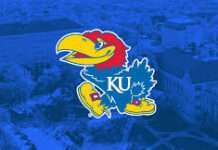Jim Blake
kansaslivingmagazine.com
Driving past a field of wildflowers is an exhilarating ride of bright flashing colors. Living in Kansas, you’re fortunate to see wildflowers everywhere. Get out of the car and take a few minutes to see Mother Nature’s bounty up close. Kansas has a multitude of wildflowers, trees, woody plants and grasses ready for you to enjoy.
Wildflowers were not intentionally planted by people. You can thank the wind, water, insects and birds for propagating the tree and flower seeds in prairies and woodlands. Most wildflowers are native to the region, but some are descendants from flowering plants grown in other environments, such as Europe.
By Color
Wildflowers grow in a rainbow of colors during spring, summer and fall. It’s quite the rainbow:
When you spot a yellow flower poking its head through a Kansas field, chances are it’s a sunflower, coreopsis, black-eyed Susan, bladderpod, goldenrod, primrose, gumweed, buttercup or lotus.
Red, pink and orange wildflowers include coneflowers, buffalo gourd, hollyhock, Indian blanket flower, paintbrush, prairie wild rose and trumpet vine.
Blues, purples, lilacs and lavenders make up chicory, spiderwort, clematis, downy gentian, larkspur and nightshade.
White and ivory flowers are plentiful, including fleabane, bloodroot, daisies, arrowhead, dogwood, jimsonweed and prickly poppy.
kansas wildflowers by color
Kansas Gardens
If you want to see a plethora of wildflowers, check out a few nature gardens in Kansas. In Wichita, you’ll find stunning botanical gardens in Sim Park, with more than 18 acres and 4,000 species of native plants. Gardens and arboretums are within driving distance in most areas. The Chaplin Nature Center features 230 acres along the Arkansas River in Cowley County. It has prairies, a floodplain forest and sandy beaches. Dillon Nature Center is a 100-acre “wild arboretum” in Reno County, with more than 200 species of woody plants and flower stems. The Baker Research and Wetlands Natural Area is in Lawrence and covers 573 acres in the Wakarusa River floodplain. No matter where you are in the state, you’re sure to find a few gardens, parks and zoos to keep you busy. Bring a guidebook to help you identify flowers and catalog your photographs.
About Kansas Native Plants
Plants and wildflowers native to Kansas soils include grasses, sedges, forb, trees, shrubs, rushes, mosses and vines. You’ll find them in gardens, forests, wetlands and prairies. Native plants sprout in particular geographic areas.
More than 2,000 plants in Kansas are vascular — they have leaves, stems and roots. Vascular plants transport nutrients and water, and they reproduce by seed. Some vascular vegetation is self-pollinating, others rely on wind and insects. Kansas has one conifer species, 200 bryophytes — nonflowering plants including mosses, hornworts and liverworts that reproduce by spores. You’ll also find more than 40 types of ferns.
Planting
With wildflower seed mixes available at garden stores, you can plant whatever you like in your home beds. September is a good time for planting sunflowers, perennial clovers and alfalfa. Check with your local nursery for seed mixes containing Maximillian sunflower or Illinois bundle flower. Partridge pea, clasping coneflower, plains coreopsis and purple prairie clover are also easy to find.
Colorful, fragrant wildflowers blanket Kansas fields and prairies. Whether you spend a few hours walking through cultivated gardens or plan a picnic on a country hillside, Kansas is blessed when it comes to flowers.
Share your Kansas wildflower photos with us on Kansas Living’s Instagram, @kansaslivingmag. You can also use #kansaslivingmag.
https://kansaslivingmagazine.com/art icles/2020/02/17/a-guide-to-kansas-wildflowers



